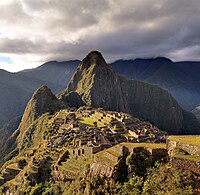
Back دولة إنكا الحديثة Arabic Inques de Vilcabamba Catalan Estado neoincaico Spanish État néo-inca de Vilcabamba French מדינת נאו-אינקה HE Negara Neo-Inka ID Stato neoincaico Italian 신잉카국 Korean Neo-Incastaat Dutch Reiaume de Vilcacamba Occitan
This article needs additional citations for verification. (November 2018) |
Realm of the Four Parts (Neo-Inca State) Tawantinsuyu (Quechua) | |||||||||||
|---|---|---|---|---|---|---|---|---|---|---|---|
| 1537–1572 | |||||||||||
|
Inca imperial banner | |||||||||||
 Modern Region of Cusco within Peru; the limits of the Neo-Inca State are unclear | |||||||||||
| Status | Independent state in Vilcabamba Vassal of the Spanish Empire (1567–1571) | ||||||||||
| Capital | Willkapampa | ||||||||||
| Common languages | Quechua | ||||||||||
| Religion | Inca religion, Roman Catholicism | ||||||||||
| Government | Monarchy | ||||||||||
| Sapa Inca | |||||||||||
• 1537–1544 | Manco Inca Yupanqui | ||||||||||
• 1545–1560 | Sayri Túpac | ||||||||||
• 1563–1571 | Titu Cusi | ||||||||||
• 1571–1572 | Túpac Amaru I | ||||||||||
| Historical era | Early modern | ||||||||||
• Manco Inca Yupanqui created the Neo-Inca state of Vilcabamba | 1537 | ||||||||||
• Treaty of Acobamba | 1566 | ||||||||||
• Spanish conquest led by Francisco de Toledo | 1572 | ||||||||||
| |||||||||||
| Today part of | Peru | ||||||||||
 |
| Inca Empire |
|---|
| Inca society |
| Inca history |
The Neo-Inca State, also known as the Neo-Inca state of Vilcabamba, was the Inca state established in 1537 at Vilcabamba by Manco Inca Yupanqui (the son of Inca emperor Huayna Capac). It is considered a rump state of the Inca Empire (1438–1533), which collapsed after the Spanish conquest in the mid-1530s. The Neo-Inca State lasted until 1572, when the last Inca stronghold was conquered, and the last ruler, Túpac Amaru (Manco's son), was captured and executed, thus ending the political authority of the Inca state.
© MMXXIII Rich X Search. We shall prevail. All rights reserved. Rich X Search
